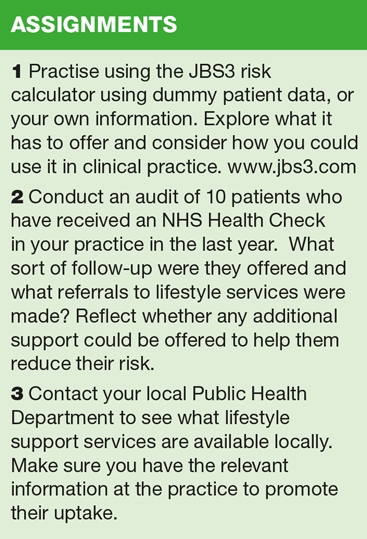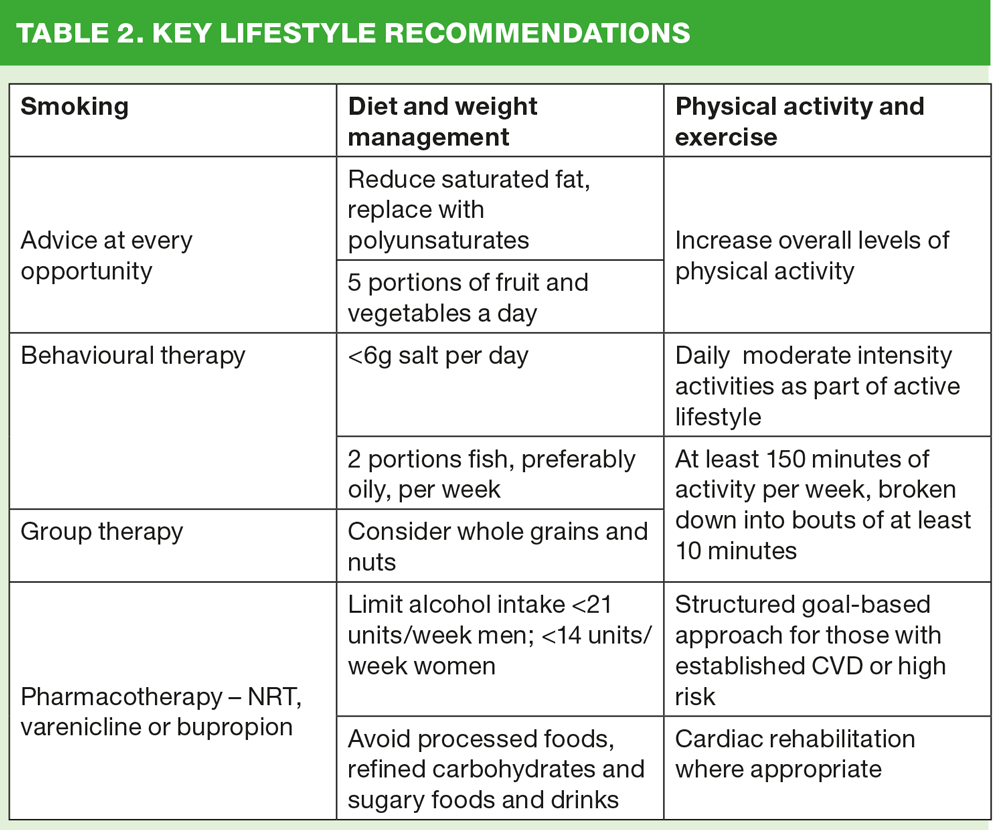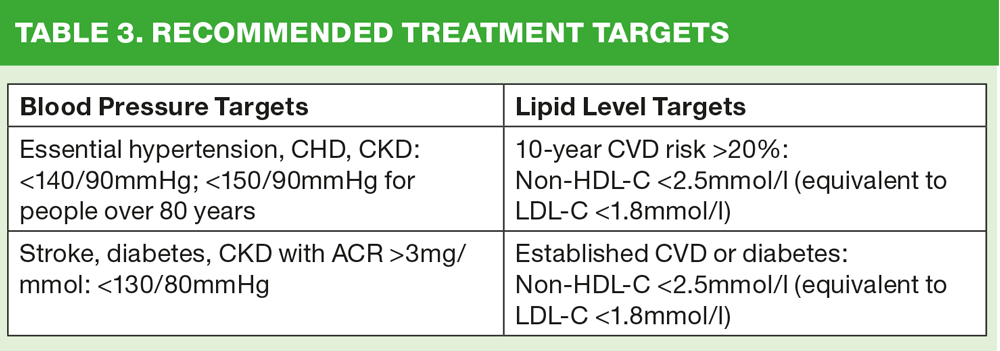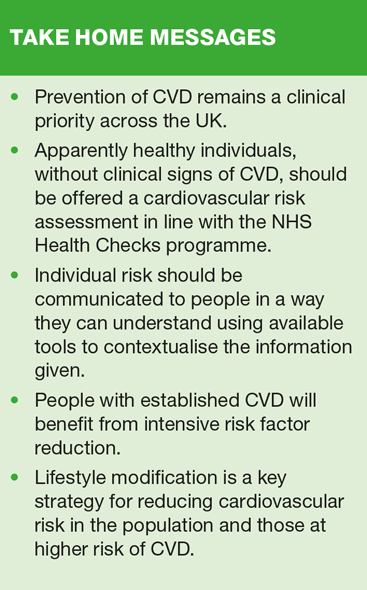CVD Masterclass: A lifetime approach to the prevention of cardiovascular disease
Joanne M. Haws
Joanne M. Haws
RN MSc
Independent Nurse Consultant in Cardiovascular Disease
Clinical Trainer, Education for Health
Almost ten years after the Joint British Societies' last consensus recommendation on the prevention of cardiovascular disease (JBS2) comes the long awaited JBS3, recommending a lifetime approach to cardiovascular risk assessment and management. So what do practice nurses need to know?
The prevention of mortality and morbidity from cardiovascular disease (CVD) is the well-established aim of a significant proportion of primary care workload. From NHS Health Checks to coronary heart disease clinics, and from hypertension monitoring to diabetes annual reviews, prevention of CVD is a part of everyday life for all primary care practitioners. One of the key challenges in CVD prevention is helping people understand the concept of risk, particularly their own individual risk, and supporting them to make the lifestyle changes that reduce it.1 The recent Joint British Societies2 consensus recommendations for the prevention of CVD — JBS3 — offers us a new approach to reducing the burden of CVD in individuals, and for the wider population by:
- Promoting a better understanding of risk
- Improving uptake of lifestyle improvements
- Improving uptake of preventative therapies.
WHERE WE ARE NOW
Premature death rates from CVD have been falling consistently since 2000.3 CVD is largely preventable and the risk factors that increase the likelihood of developing disease are the same the world over.4 Medical treatments have been responsible for about half of the reduction in mortality and approximately one third is attributable to lifestyle changes such as stopping smoking, reducing cholesterol and being more active.
Despite massive advances the job is far from done and, with an ageing population, rising retirement age and increased poverty, it is more important than ever to try to keep the population healthy.3 The CVD Outcomes Strategy was published last year to provide advice to the NHS and local authorities on improving outcomes for people with, or at risk of CVD and the NHS Health Checks Programme is the key deliverable in the primary prevention of CVD.5,6 JBS3 now forms a welcome addition to the toolkit of resources available to identify and address CVD risk in individuals.
LIFETIME RISK
The key change in the approach to assessing CVD risk in JBS3 is the introduction of the concept of 'lifetime risk'. Until now risk stratification and prevention strategies have been based on the quantification of an individual's absolute risk of developing disease over the next ten years. While this strategy does enable those with the highest short-term risk to be identified and offered treatments, it does little to address risk in the majority of younger people.2
JBS3 describes the 'continuum of risk' in the population and highlights that most CVD events occur in those at 'intermediate' risk.2 Current guidance would not indicate the use of preventative therapies in this group,7 but it is argued that more people could be motivated to make lifestyle changes if their risk of CVD over their lifetime was communicated. It is also pointed out that people could be falsely reassured by a low 10-year risk score, particularly younger people and women, and that these individuals could have substantially elevated modifiable risk factors contributing to a higher risk over their lifetime. In essence, JBS3 provides us with a new approach, enabling us to give meaningful information to those people who are living an unhealthy lifestyle today and may be storing up potentially devastating health problems for the future.
THE RISK CALCULATOR
A new risk calculator has been developed for JBS3. Unlike the previous JBS2 calculator, which was based on the Framingham Risk Score, JBS3 uses 'QRISK Lifetime'8 as a basis for risk assessment. The rationale for this is the option of a calculation of lifetime risk. The fact that the QRISK algorithm is based on a UK population also makes it more relevant to UK practice.
The new calculator still provides a 10-year risk score, making it useable for NHS Health Checks, but adds novel measures such as 'Heart Age' and 'CVD event-free survival'. The latter expresses how long an individual can expect to survive without a heart attack or stroke, assuming they don't die of something else in the meantime.
A key benefit of the JBS3 calculator in practice will be its capability to display risk in a number of ways. This will facilitate communication with the individual about their risk in both the short and longer term, their heart age compared with their chronological age and the impact of interventions on their risk. The interactive nature of the calculator allows the user to change risk factor levels and add in interventions, demonstrating how lifestyle changes or therapy will affect risk. For example, you can adjust blood pressure levels or change smoking status to show a person how this could reduce their risk. You could also use the calculator to see what impact drug therapy would have on risk in order to help individual decision making. This could be particularly useful in older patients in helping them decide whether or not they want to take a statin. Understanding modifiable risk in terms of actions and consequences should empower people to make more informed decisions regarding their lifestyle and recommended therapies.
HEART AGE
'Heart Age' is a new, evidence-based concept that provides a simple, easily understandable way of estimating and expressing risk. It uses the same risk factor information as the 10-year risk score but translates this into a person's heart age, which can then be compared with their chronological age.
A recent study involving 3,000 people evaluated the impact of using Heart Age to promote healthier lifestyles and improve CVD risk factors compared with a conventional risk score tool.9 The results showed that using Heart Age to raise awareness of CVD risk promoted behavioural changes that resulted in a decrease in risk and a reduction in Heart Age. The study indicated that Heart Age was more effective than the conventional risk score in encouraging participants to adopt healthier lifestyle and reduce their CVD risk. The term has been introduced by JBS3 to help individuals visualise their current risk rather than relating it to events that may or may not happen in the future.2
RECOMMENDED INTERVENTIONS
Lifestyle
JBS3 has strived to find new ways of empowering people to make positive lifestyle changes to reduce their lifestyle risk. The consensus recommendations place great emphasis on supporting lifestyle modification with a focus on smoking, diet and physical activity. A summary of the recommendations can be seen in Table 2.
Smoking
JBS3 supports NHS England's 'Making Every Contact Count' initiative.10 It recommends that professional support on how to stop smoking be given at every opportunity. Recommendations on stopping smoking are in line with current guidance and practice in the provision of behavioural counselling, group therapy and pharmacotherapy. Again, the added value of JBS3 comes not in new treatment recommendations but rather in how the risk of smoking can be quantified and presented to the individual. The JBS3 calculator emphasises the benefits of early smoking cessation and the diminishing, but still substantial gains to be made for older people in quitting the habit.2
Diet and Weight Management
Dietary recommendations highlight the need to give professional support to individuals so they are encouraged to eat a diet associated with the lowest cardiovascular risk. This follows the evidence-based principles of an intake low in saturated fats, replacing with polyunsaturated fats where possible and including oily fish.
Individuals should be encouraged to eat five portions of fruit and vegetables per day and consider regular consumption of nuts and whole grains. Salt should be limited to less than 6 grams per day and alcohol should be within current recommended limits. People should generally be advised to reduce or avoid processed foods, refined carbohydrates and sugary foods and drinks.
JBS3 notes that these principles should be supported for all individuals, including children and young adults. This is emphasised by the recommendation that obesity in children and young people should be managed using the 'lifetime risk' message; furthermore healthcare professionals should, with appropriate training, be able to undertake the '3 A's' approach: Ask, Assess adiposity and Advise on evidence based ways to target weight change in appropriate adults.
Physical activity and exercise
JBS3 highlights that there is an overall need for the population to be more active to reduce CVD risk and recommends daily moderate intensity activities as part of a healthy, active lifestyle. Individuals should be encouraged to undertake at least 150 minutes per week of aerobic activity broken down into smaller bouts of at least ten minutes. People with established CVD or those at high risk should be managed with a more structured approach with a focus on goal setting and, where appropriate, cardiac rehabilitation.
Therapies
For the primary prevention of CVD, JBS3 therapy recommendations focus on blood pressure control and lipid modification, accompanied by professional lifestyle support.
The consensus is generally to follow NICE guidance for the management of hypertension and for lipid lowering in high-risk individuals, although JBS3 does suggest targets for lipid lowering (Table 3) for those receiving treatment. These targets levels are repeated in lipid-lowering recommendations for people with established CVD risk, which should help avoid confusion in practice. However, JBS3 endorses the use of non-HDL cholesterol as a predictor of risk and a measure of treatment efficacy rather than total cholesterol and LDL cholesterol alone. This will be a new approach for most healthcare professionals. We are also reminded that addressing overall CVD risk rather than focusing on blood pressure and lipid lowering alone is likely to be most beneficial, and that there is no role for aspirin in the primary prevention of CVD.
For people with established disease there are detailed recommendations including intensive statin therapy for patients post myocardial infarction, anticoagulation for individuals with atrial fibrillation and antiplatelet therapy in peripheral arterial disease (PAD). The influence of diabetes on CVD risk is also addressed with specific recommendations on control of blood pressure, lipids and glycaemia in people with both type 1 and type 2 diabetes.
Patients with cardiovascular disease
JBS3 addresses risk in all people and is not limited to the process of risk assessment. As you would expect, the risk scoring tools are only appropriate for individuals without existing CVD (Table 2). People with established disease, of any nature within the cardiovascular spectrum (Figure 1) have the highest level of risk and will benefit from intensive risk factor modification.2
In response to increasing evidence, and in line with the CVD Outcomes Strategy,4 JBS3 emphasises that individuals with evidence of CVD should be treated in a similar way, regardless of clinical presentation and the vascular territory affected. In other words, whether you have had an MI or stroke, or suffer with PAD or any other form of CVD the principles of treatment should be the same. The key treatment aim for all people with CVD is to delay disease progression and prevent cardiovascular events.2
There are extensive recommendations for risk reduction in coronary artery disease, stroke, PAD, diabetes and chronic kidney disease (CKD), reflecting the high-risk nature of these groups. Despite the general consensus of intensive risk factor lowering for all, JBS3 suggests that the risk calculator could be used with individuals with CKD specifically to highlight the increased risk and guide risk factor modification.
OTHER RECOMMENDATIONS
In response to recent evidence highlighting increased risk of CVD in people with chronic inflammatory conditions11 the JBS3 calculator incorporates a multiplier for the presence of rheumatoid arthritis. The increased risk is thought to be largely driven by systemic inflammation. Therefore, in affected individuals, optimisation of inflammation suppression therapy is recommended along with intensive lowering of conventional risk factors. It is recommended that practitioners use their clinical judgment to determine whether a multiplier should be applied to patients with other autoimmune conditions.2
People with chronic obstructive sleep apnoea are also identified as a potentially high-risk group. It is recommended that risk assessment and lifestyle advice, particularly to support weight loss should be offered to all patients affected.
SUMMARY
The need to quantify cardiovascular risk and offer interventions to those at higher risk, along with advice and support to help those at lower risk to remain healthy, remains the same. Public health programmes such as NHS Health Checks and disease management strategies in primary and secondary care will continue to be the key methods of delivering improvements in cardiovascular health.
JBS3 serves to enhance existing initiatives by supporting the all-important communication of risk to individuals, and in doing so should promote the uptake of lifestyle changes and therapies to reduce CVD risk. There is little to be gained from taking measurements and questioning people about their risk factors if they are unable to understand the significance of the results and how they can influence them.
We now have a variety of ways to present information to people, empowering them to make informed decisions about their future. There seems to be no real 'right or wrong' way to present and discuss these results with people. The skill may be in finding out which method 'talks' to the individual and is meaningful to them. JBS3 gives us a number of ways of doing this without inhibiting the delivery, recording and reporting of current requisite strategies that measure performance and effectiveness.
REFERENCES
1. Webster R, Heeley E. Perceptions of risk: understanding cardiovascular disease. Risk Management and Healthcare Policy 2010; 3:49-60
2. JBS3 Board. Joint British Societies' consensus recommendations for the prevention of cardiovascular disease (JBS3). Heart 2014; 100:ii1-ii67
3. Townsend N, Wickramasinghe K, Bhatnagar P et al. Coronary heart disease statistics 2012 edition. British Heart Foundation: London
4. Yusuf S, Hawken S, Ounpuu S. On behalf of the INTERHEART Study Investigators. Effects of potentially modifiable risk factors associated with myocardial infarction in 52 countries (the INTERHEART Study) case control study. Lancet 2004; 364:937-952
5. Department of Health. Cardiovascular Disease Outcomes Strategy, 2013. https://www.gov.uk/government/uploads/system/uploads/attachment_data/file/217118/9387-2900853-CVD-Outcomes_web1.pdf
6. Public Health England. NHS Health Check implementation and review and action plan. July 2013. NHS England.
7. National Institute for Health and Care Excellence. Lipid modification: cardiovascular risk assessment and the modification of blood lipids for the primary and secondary prevention of cardiovascular disease. 2014. NICE
8. Hippisley-Cox J, Coupland C, Robson J, Brindle P. Derivation, validation, and evaluation of a new QRISK model to estimate lifetime risk of cardiovascular disease: cohort study using QResearch database. British Medical Journal 2010;341:c6624
9. Lopez-Gonzales A, Aguilo A, Frontera M et al. Effectiveness of the Heart Age tool for improving modifiable cardiovascular risk factors in a Southern European population: a randomized trial. European Journal of Preventative Cardiology 2014; doi: 10.1177/2047487313518479
10. NHS England. Making Every Contact Count. 2012 http://www.makingeverycontactcount.co.uk
11. Peters M, Symmons DOM, McCarey D et al. EULAR evidence-based recommendations for cardiovascular risk management in patients with rheumatoid arthritis and other forms of inflammatory arthritis. Annals of Rheumatic Diseases 2010; 69:325-331






